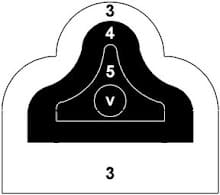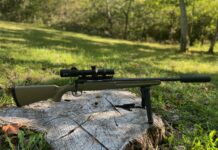In part one of this series, I talked about my first day experience at an Appleseed shoot. It was a very challenging day both in terms of the weather and the equipment problems that I had. Despite all of this, I decided to show up for the second day in hopes of shooting a Rifleman score on the Army Qualification Test (AQT). I woke up on Sunday and couldn’t believe how much everything ached. You’d have thought I spent the day hauling bricks around rather than shooting .22 rifles. My body was clearly not used to being contorted into those various positions and it was letting me know that. Two Advil and a half hour later, I was ready to move out for Day 2 of the Appleseed weekend . . .
Having learned my lesson from the previous day, I left the traitorous Ruger 10/22 in a pile of parts (having disassembled it the night before to help dry it out) and grabbed my trusty SIG SAUER 522 rifle. Since there was to be a known distance (KD) component of the Appleseed shoot at 100 yards, I also elected to bring my SIG 516 patrol rifle along.
Fortunately, it appeared that better weather was in store for us Sunday following the monsoon we experienced on Saturday. The first activity of the day was the KD component. The KD shoot is an optional long range activity that’s offered to those who wish to shoot it. It’s not scored for Rifleman, but gives participants the opportunity to test their skills at an actual long distance as opposed to simply shooting scaled down targets at 25 meters.
The Goffstown Fish and Game Club had a 100 yard range available and that is what we used. Well, that is what they used. In the interest of full disclosure, I have to admit that I did not manage to drag my sorry butt out of bed on Sunday until about 9:00. The shoot began at 8:30, so when I strolled in around 10:15 or so, the KD component was over and the shooting stations had been positioned back on the 25 meter line for AQT shooting again.
Upon arriving, I found three other Appleseeders had returned and I made four. Two of the three who had shot Rifleman scores the previous day had decided not to return – not surprising as they had met their goals, so why spend another day in the mud?
The one Rifleman (or should I say Riflewoman) who had returned had done so, largely I suspect because she was with one of the instructors. She certainly had nothing to prove as she had made Rifleman the previous day on her first Appleseed. The upshot of this is that we now had roughly a 1.5 to 1 ratio of instructors to participants which means that we received near constant attention and feedback from people who knew what to look for.
I broke out my 522 and it didn’t let me down. I had one or two misfeeds, but they were quickly corrected with a pull on the charging lever. The funny thing is that since I got the Ruger, I had contemplated selling my 522 as I saw no real need for two .22 rifles in my collection and could have used the money to buy something else that I wanted. After today, that ain’t gonna happen.
The 522 is a reliable rifle and I’m definitely keeping it. Unfortunately, my equipment failure problems were not over. This time around, it was the damn Nikon Prostaff Rimfire scope that decided to bail on me. Despite Nikon’s claims to the contrary, the Prostaff was not in fact “impervious to water and fog” and by mid-day had developed a nice fog circle centered around the middle of the reticule as a result of being constantly in the rain the previous day. The problem here is that with the simulated 400 yard targets being scarcely larger than an inch square, the fog circle pretty much obliterated my ability to align the cross hairs with the target.
Following lunch, I decided to remove the scope and set up the iron sights. We shot a few more AQTs and then decided to take a break and run a Ball and Dummy drill. To run this drill, shooters pair up with one person on the gun and one person feeding the shooter with a magazine that is either loaded with a live round (the ball) or an empty magazine (the dummy). The shooter doesn’t know whether he has a live round in the chamber or not and sets up to take the shot. The object of this drill is to test for a flinching reaction.
The loader watches the shooter carefully during the shot looking for signs of flinching. The idea is to help the shooter eliminate the flinch with dummy magazines so that when they fire the live rounds, their shots will fly true. While this might help some folks, the fact is that I have shot enough .22 that I am simply not going to flinch. It probably would have been more effective if I had been firing my .223 or .308 as those rifles are much more likely to cause me to flinch.
Then it was back to shooting AQTs. Unfortunately, my iron sights were the next thing to let me down. My shots went consistently low and despite moving my rear sight as far as I could, I simply could not bring my groups on target. I’m sure that given time, I can figure out how to adjust the front and rear sights in combination to get my shot group where I want it, but I simply didn’t have the time or the instructions handy to do it in the field.
I decided that enough was enough and I retired the SIG 522 in favor of my 516. Fortunately, I had brought several hundred rounds of .223 ammo with me as I was going to need them. It took a couple of AQT rounds before I got my sights dialed in for 25 meters since they had previously been zeroed for 100 yards. A few more AQTs with one achieving a score of 200 – just ten points shy of the Rifleman score. Finally, I settled down and managed to shoot a very good set. A few rounds went wide of the mark, but when I went to retrieve my target, it looked like I might finally have managed to attain the desired score. An initial review put my score at 206 – still four points shy, but given how close I was, several more instructors were called in to verify the score and to pass judgement on shots that were on the edge of breaking the lines separating the score circles. The determination went my way and I successfully attained Rifleman with a final score of 213.
 After that, I was pretty much done for the day. The event concluded with some final thoughts on what we had learned over the weekend – both the marksmanship and the history and I was awarded my Rifleman patch. The final tally for the event was four out of the six who had come to the event achieved the Rifleman patch – and the two who didn’t had been new shooters who improved their skills significantly.
After that, I was pretty much done for the day. The event concluded with some final thoughts on what we had learned over the weekend – both the marksmanship and the history and I was awarded my Rifleman patch. The final tally for the event was four out of the six who had come to the event achieved the Rifleman patch – and the two who didn’t had been new shooters who improved their skills significantly.
I was amazed at how much this one weekend had improved my shooting. I’m now also a firm believer in the difference a properly adjusted sling – a 200 year old invention – makes in one’s shooting. That and following the principles we had been taught such as proper breathing and the Natural Point of Aim had all contributed to my effectively doubling my shooting score over the course of two days.
I’ve said it before, but it bears repeating – Appleseed will make you a better shooter and when you compare two days of instruction for $70 (or less) to the cost of attending a professional school (a two day class at the SIG Academy will run you close to $400), there is no reason not to attend an Appleseed in your neck of the woods.






Is it a two day class, or did you go back for a second time just to get the patch?
They are normally run as a two day class although you can do only one day if you want. I recommend going both days. For the price it’s hard to beat. You get some good instruction and a lot of trigger time. They don’t teach anything earth shattering or innovative just solid basics.
Anyone have any experience with a AR-7? Would that be ok to use for this? I’ve thought about appleseed, just havent gotten around to buying a .22, and i’m assuming it would be better to try it the first time with a .22 rather than .308.
I wouldnt do it with an AR-7. You really wouldn’t be doing yourself any favors, it just isn’t set up for the kind of shooting you would be doing. A 10/22 or Marlin 795 are both great especially if you upgrade the sights. Honestly I would skip the AR-7 altogether if you haven’t bought it already. Neither me or anyone I know who owns one has had good luck with them.
Thanks. I’ve never shot one before, it just seemed like a cool idea.
Congratulations! That is a truly hard-won award, which very few people will ever achieve. Appleseed is an amazing bargain when it comes to training. You might even want to take the class more than once. You simply can’t beat that price for two days of good instruction.
Jim, big thanks for the info. There are a half dozen of the shoots coming up in Massachusetts and I’m going to one. It sounds like fun!
“We need some form of militarized police forces[…]”
Credibility: Lost
What was that a response to? I don’t see it in the article.
It should have linked to the author’s article In Defense of SWAT(http://www.thetruthaboutguns.com/2012/06/jim-barrett/in-defense-of-swat-2/), where he tries to justify the unconstitutional crimes of the State because they’re “necessary”.
Because the two subjects are connected…how?
Thanks for the great article! Your synopsis of the history is excellent, and it was a pleasure to have you out on the line.
If you want to see pictures from the event, here is a link to the Facebook album below. Please “Like” the page to get updates from NH Project Appleseed for upcoming events, news, and musings as well.
https://www.facebook.com/media/set/?set=a.408300712547428.94119.186407501403418&type=3
One important point for the casual reader is that Project Appleseed now has the “Rifleman Opportunity Card”. If you complete your first shoot and have not reached a Rifleman score you can come back as often as you want for one year free of charge until you do make Rifleman. Note; You still may need to pay a range fee to the host club, but the instruction is on Appleseed.
For the reader above who has the single shot break action, we sometimes have loaner rifles. When an Appleseed instructor loans you a rifle, you may be sure that the rifle will do its part. Then it’s up to you.
Do not expect to come to a shoot with a group of people and receive enough loaner rifles for everybody. We Instructors don’t own that many rifles. These are personal rifles. They do not belong to the Appleseed Project.
Wonderful, what a webpage it is! This blog gives helpful information to us, keep it up.
Despite all of my many complaints, it is far from the worst video game-based flick.
The opening cinematic had a few choppy collisions, primarily when the swords were entering the body.
You often gather quests via rumors your hear from your companions,
rather than the job boards that existed
in the previous game.
Thanks for sharing
Comments are closed.